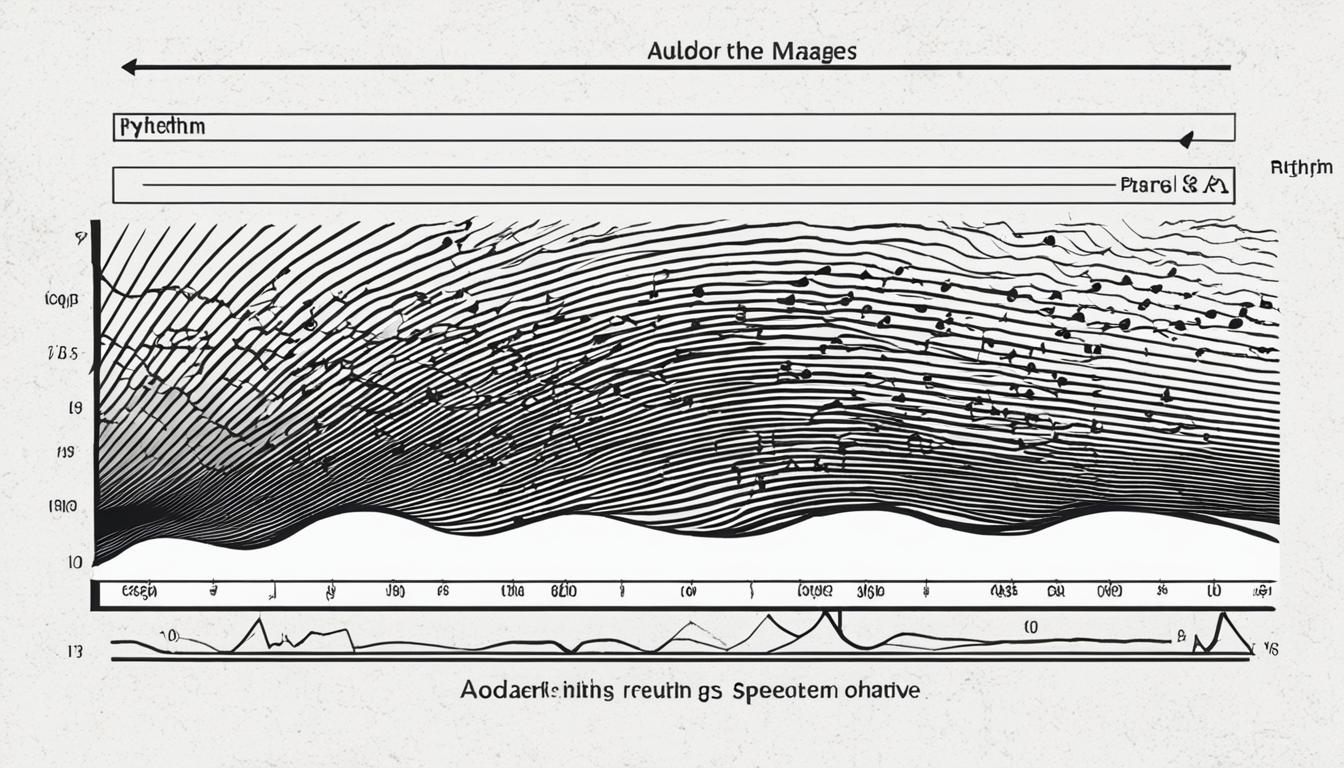As an audiobook narrator, delivering a captivating performance is crucial to engage your audience and leave a lasting impression. One of the most critical aspects of audiobook narration is speech pacing, which directly affects the listener’s comprehension and engagement. Pacing involves finding the right balance between speed, rhythm, and timing, ensuring that the listener can follow along effortlessly. In this article, I will explore the essential techniques to achieve optimal speech pacing, enhancing the overall quality of your audiobook narration.

Key Takeaways
- Pacing is a crucial aspect of audiobook narration, impacting the listener’s experience.
- Speech pacing sets the rhythm, flow, and tempo of the narration, influencing the listener’s comprehension.
- By mastering speech pacing, audiobook narrators can create an engaging listening experience for their audience.
- Speech pacing involves finding the right balance between speed, rhythm, and timing.
- The techniques in this article will help you achieve optimal speech pacing as an audiobook narrator.
Understanding the Importance of Speech Pacing
As an audiobook narrator, I understand the crucial role that speech pacing plays in creating a captivating and engaging listening experience for the audience. The rhythm, flow, and overall tempo of the narration are set by the pacing and can greatly impact the listener’s comprehension, engagement, and enjoyment of the content. It is essential to maintain the right balance between speed and clarity, ensuring that the listener can follow along effortlessly.
Speech pacing is not merely about speaking quickly or slowly. It is about finding the right pace that matches the tone and mood of the content and allows the listener to connect with the story. When done effectively, speech pacing can add texture, create suspense, and emphasize critical information.
For example, when narrating an action-packed scene, increasing the pacing can add tension and excitement. Whereas, when narrating a meditation guide, a slower pace will allow the listener to relax and focus on the instructions. Thus, it is essential to understand the importance of speech pacing to create an excellent listening experience for the audience.
“Speech pacing sets the rhythm, flow, and overall tempo of the narration, influencing the listener’s comprehension, engagement, and enjoyment of the content.”
Utilizing pauses effectively
As I mentioned earlier, pauses are a critical component of speech pacing in audiobook narration. When utilized strategically, a well-placed pause can have a profound impact on the listener’s experience. Pauses can create suspense, emphasize important points, and allow the listener to process information.
One effective technique for incorporating pauses is to use them to break up longer sentences. By inserting a brief pause between clauses or phrases, you can give the listener time to absorb the information and prevent them from feeling overwhelmed.
Another way to use pauses effectively is to incorporate them into dialogue. When transitioning between different speakers, inserting a short pause can help differentiate between the voices and prevent confusion.
It’s essential to remember that pauses should feel natural and not forced. Overusing pauses or inserting them in awkward places can detract from the listener’s experience. Therefore, it’s crucial to practice using pauses and identifying the right places to use them for maximum impact.
By utilizing pauses effectively, you can improve the flow and rhythm of your narration, creating a more engaging and dynamic listening experience for your audience.
Varying the speed and rhythm of delivery
As an audiobook narrator, it’s important to keep your listener engaged throughout the narration, and a monotonous pace can quickly bore them. Varying the speed and rhythm of delivery helps add texture and contrast, making the narration more captivating.
To effectively vary your speed and rhythm, you can use techniques such as:
- Speeding up or slowing down during exciting or reflective parts
- Pausing before key phrases to create anticipation
- Slowing down during important sentences to emphasize their impact
- Using different intonations during character dialogue to denote different emotions
However, it’s important to remember that excessive variation can also be distracting and confusing for the listener.
The key is to strike a balance between consistency and variety in your speech pacing to drive the listener’s interest and comprehension, without being excessively repetitive or erratic. By practicing techniques to vary speed and rhythm, you can infuse your narration with energy and nuance, captivating the listener from start to finish.
Emphasizing key words and phrases
When narrating an audiobook, it’s essential to emphasize key words and phrases to highlight important information and capture the listener’s attention.
One effective technique for emphasizing key words and phrases is inflection. By placing stress on the important words, you can convey their significance to the listener without sounding unnatural or forced.
Another technique is to use pauses strategically. Pausing before or after a key word or phrase can draw attention to it, giving the listener time to process and reflect on its meaning.
“The most important thing is to focus on the message, not just the words.”
Additionally, using varied pace can help emphasize key words and phrases. Slowing down or speeding up during specific parts can help to draw attention to important information.
Remember, the key is to use these techniques effectively without distracting from the overall flow of the narration.
By emphasizing key words and phrases, you can enhance the listener’s understanding and enjoyment of the audiobook.
Matching Pacing with Tone and Mood
One of the most critical aspects of effective speech pacing is aligning it with the tone and mood of the content. Every audiobook has a unique emotional landscape that requires a distinct pacing approach. In some cases, a fast-paced narration may be suitable, while in others, a slower pace may be ideal.
Matching pacing with tone and mood helps the listener engage and empathize with the characters and storyline. Suspenseful thrillers need varying pacing to bring out the tension, uncertainty, and drama effectively. Conversely, a lighthearted romance audiobook needs a more straightforward and consistent pace to bring out the romantic mood effectively.
As an audiobook narrator, it’s crucial to master speech pacing techniques that help align with the emotional nuances of the content effectively. Matching the pacing with the tone and mood helps transport the listener into a world of imagination and adventure, making the overall experience immersive and engaging.
“The success of an audiobook heavily relies on the narrator’s ability to transpose the listener to the emotional landscape of the story. Albert, a seasoned audiobook narrator, emphasizes the importance of matching the pacing with tone and mood, stating that it’s an essential element in delivering a captivating performance.”
One practical tip for matching pacing with tone and mood is reading the manuscript at least once before recording. This helps familiarize oneself with the story’s emotional arc, enabling one to set the right pacing that complements the tone and mood. Additionally, noting the characters’ emotional states or setting can be useful in determining the pacing required for each scene.
By aligning the pacing with the tone and mood, audiobook narrators can create a listening experience that keeps the listener engaged, making it more enjoyable and memorable.
Practicing Breath Control and Enunciation
Breath control and clear enunciation are essential components of effective speech pacing. As an audiobook narrator, it’s important to focus on maintaining a steady flow of air while speaking and articulating each word clearly. Doing so not only enhances the listening experience for the audience but prevents the narrator from running out of breath and sounding winded.
One way to practice breath control is through regular breathing exercises. Deep breathing is an excellent way to increase lung capacity and control the flow of air from the lungs. To do this, inhale slowly and deeply through the nose, filling the lungs, and then exhale through the mouth, taking twice as long as the inhalation. Repeating this exercise three to four times a day can significantly improve breath control.
Clear enunciation involves properly pronouncing each word, ensuring that the listener can easily comprehend the content. To improve enunciation, practice speaking slowly and emphasizing certain sounds to prevent slurring or mumbling. Practicing tongue twisters is also an effective way to improve diction, clarity, and overall enunciation.
“Sally sells seashells by the seashore” is a classic tongue twister that can significantly improve enunciation.
Remember to take breaks during recording sessions to prevent fatigue and maintain vocal quality. By incorporating breath control and enunciation techniques into your regular practice routine, you can improve your speech pacing and provide a seamless and professional audiobook narration.
Seeking feedback and continuous improvement
As an audiobook narrator, I understand the importance of seeking feedback for continuous growth and improvement. It can be challenging to objectively assess one’s performance, especially since we tend to be our own worst critics. However, by seeking feedback from listeners, peers, or professionals in the industry, we can gain valuable insights into our strengths and weaknesses.
Constructive criticism can be a powerful tool for growth. It can help us identify areas where we need to improve and provide us with specific suggestions for doing so. Whether it’s feedback on pacing, enunciation, tone, or any other aspect of narration, it can help us refine our craft and take our skills to the next level.
While feedback can be valuable, it’s important to keep in mind that not all feedback is created equal. It’s essential to seek feedback from trusted sources who have experience and expertise in the industry. Additionally, we should be open-minded and receptive to feedback, even when it’s not what we want to hear. By approaching feedback with an open mind and a willingness to learn, we can turn it into a powerful tool for improvement.
Continuous improvement is a journey, not a destination. By seeking feedback, incorporating suggestions for improvement, and consistently practicing our craft, we can continue to grow and develop as audiobook narrators. There is always room for improvement, and by embracing this growth mindset, we can continually enhance our skills and provide our listeners with the best possible experience.
So, if you’re an audiobook narrator looking to improve your speech pacing, don’t be afraid to seek feedback and embrace a growth mindset. By doing so, you can take your skills to the next level and provide your listeners with a truly captivating and engaging listening experience.
